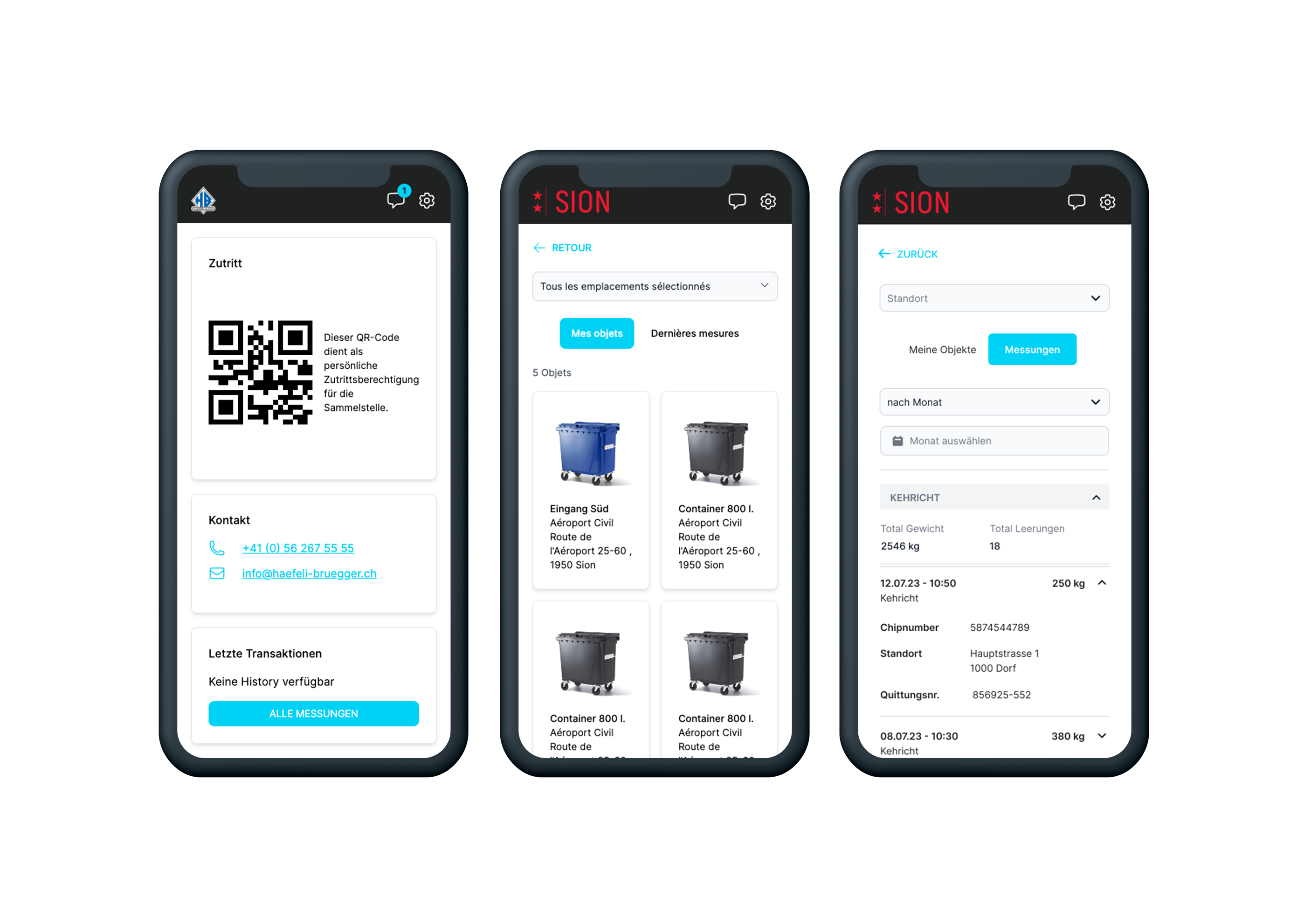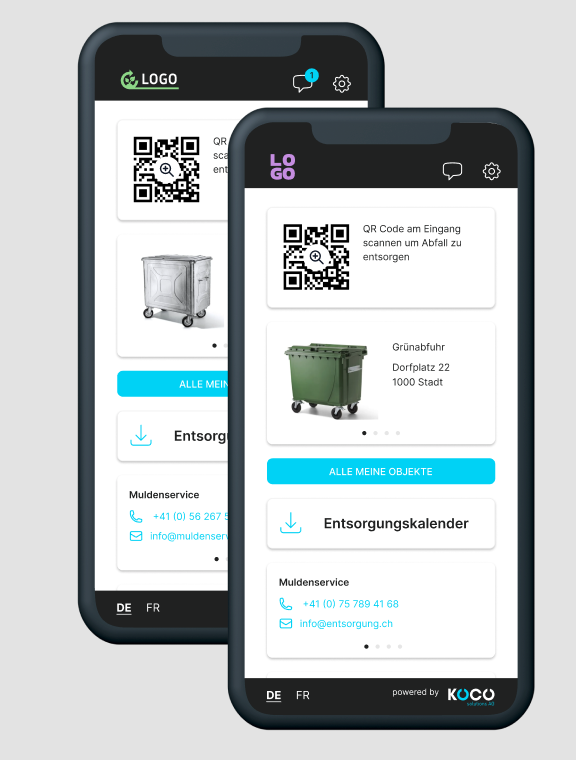
A Customer Portal - modern waste disposal on demand
Customer
Koco Solutions AG
https://www.koco.online/
Technologies
React
.net Core
Strapi CMS
Keycloak
Disciplines
Strategie & Consulting
UX & UI Design
Software Development
Optimized work processes and transparency in the recycling and waste disposal industry thanks to a customer portal
KOCO Solutions AG's customer portal - a digital and modern solution - offers a unique user experience for on-demand waste disposal.
Services related to waste disposal can be requested quickly and easily in the customer portal with a click on a smartphone. These "on demand" functions give users new flexibility when recycling and disposing of waste. Waste is no longer emptied in a fixed cycle, but as required. This not only allows resources to be conserved and used more efficiently, but the use of the portal also provides maximum transparency and control. All data can always be viewed conveniently and in detail online. This allows, for example, automatic total billing per customer. This significantly reduces the administrative workload.

Screen on the left: Individually generated QR code for access authorization, middle and right screen: Overview of all waste garbage cans and their history
Various possible functions are available in the clear start view of the portal
- Overview of all disposal containers (waste type) incl. exact location
- History of empties per disposal container including details of waste type and weight
- Data export function in Excel or PDF
- Contact details of the respective waste disposal service provider
- Option to generate a QR code for access control to the disposal yard (e.g. for municipalities)
Technical implementation and challenges of the customer portal
Sitewerk designed and developed the customer portal according to the mobile first approach, as the application is primarily used by facility managers, depot employees and residents on mobile devices. In order to design a sensible and efficient architecture, the first step was to gain a precise understanding of the KOCO-online Internet weighing portal with its modules and data structures. All weighing data and/or geolocalization as well as the route optimization of the vehicle fleet are managed there and are connected to the billing program of its users. The requirements for the new customer portal also had to be precisely defined and prioritized. We designed the various user flows and clarified how they interact with KOCO-online. Based on this information, we created the optimal software architecture and defined the CMS and data storage. In order to connect the customer portal with the existing KOCO-online software, we had to build an interface to its backend.
These are the most important aspects that need to be considered when developing software and implementing interfaces:
Data format and structure
Different systems can use different data formats and structures. The challenge is to ensure that the data from both sources is interpreted correctly and displayed uniformly in order to provide consistent information in the customer portal.
Interface communication
Communication between the customer portal and the existing systems requires clear and reliable interfaces. The selection of suitable protocols and standards for data transmission is crucial in order to avoid interoperability problems.
Data security and data protection
When sensitive data is involved, appropriate security mechanisms must be implemented to ensure the confidentiality and integrity of the data during transmission and storage. Compliance with data protection regulations and guidelines is of paramount importance.
Data quality and cleansing
Different data sources can provide inconsistent or incorrect information. It is important to implement data quality checking and cleansing mechanisms to ensure that only accurate and reliable data is displayed in the customer portal.
Real-time data update
In order to display bin emptying in real time, it is necessary to implement mechanisms for real-time synchronization between the customer portal and the underlying systems.
User-friendliness and consistency
The customer portal should offer a consistent user interface, regardless of which system the data comes from. The challenge is to ensure a seamless user experience and that users can easily understand the functionalities of the portal. The portal is used in both the B2B and B2C sectors and must be intuitive to use for both segments.
Scalability
The software architecture must be scalable in order to cope with growing data volumes and user numbers. This requires careful planning and implementation in order to guarantee the portal's performance even with increasing complexity.
Cooperation between the companies involved
Cooperation between the companies involved is crucial. Clear agreements on data access, interface standards and joint development processes are required to ensure smooth integration.
The following points were important for the successful cooperation with Koco Solution AG:
- Clarifying requirements in joint workshops
- Good designs for a comprehensible basis for communication
- Regular exchange with the KOCO-online development team
- 2-weekly exchange with demos of the current development status
«We value the professional approach and different areas of expertise within the Sitewerk team. This ensures that various aspects of a project/product are comprehensively taken into account. This is of great importance to us in order to develop not only successful but also future-oriented solutions.»
Claudio Zimmerli, CEO

Multi-tenancy solution for efficient SaaS
The KOCO customer portal was designed to be multi-tenant capable. This means that this software application can be used by several different customers (tenants) at the same time, while the data and transactions of the individual customers remain separate from each other. It is particularly advantageous for companies that want to offer services or software products to a large number of customers. We used Strapi as the content management solution (CMS) for this project.
Strapi - What is it?
Strapi is one of the leading open source headless CMS. Strapi can be used for the development of mobile applications, eCommerce sites and APIs. Strapi consists of 100% JavaScript and is extensible and customizable at all levels. The entire Strapi code base is available on GitHub. Strapi is a big player on GitHub with over 51k stars. Strapi is characterized above all by its high level of customizability and extensibility. Developers can customize and extend all aspects of the Strapi CMS. This includes
- Look & Feel of the Admin UI
- Functions of the API
- Used Plugins
- Hosting
Strapi also offers the developer several options for obtaining the content stored in the CMS. The CMS automatically creates APIs based on the content created. The data can therefore be obtained either via RESTful API or GraphQL. And from almost any client. The same applies to hosting. Since Strapi follows the "self-hosted" approach, you are free to decide where and how Strapi should be hosted.
White labeling for quick and easy customization
In order to make the adaptation to the branding of an organization or company relatively simple, the white labeling method was used. The underlying technology and functionality remain largely the same, but the appearance, color scheme, logo and other visual elements are adapted to the CI/CD (corporate identity) of the third-party provider.
Future plans - Modern waste disposal on demand
The aim of Koco Solutions AG is to further modernize and optimize waste disposal and recycling. The first development steps for further options have already been taken. In future, it should be possible to dispose of waste on demand. 3 further options are: Empty bin, wash bin, order skip. These functions are being planned and will be implemented soon.
We have more interesting Projects to offer
References

